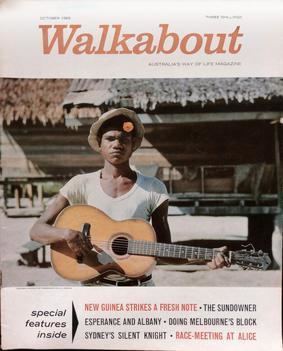 | ||
Walkabout was an Australian illustrated magazine published from 1934 to 1974 combining cultural, geographic, and scientific content with travel literature. Initially a travel magazine, in its forty-year run it featured a popular mix of articles by travellers, officials, residents, journalists, and visiting novelists, illustrated by Australian photojournalists. Its title derived from the supposed ‘racial characteristic of the Australian aboriginal who is always on the move" [1].
Contents
History
Ostensibly and initially a travel and geographic magazine published by the Australian National Travel Association (formed in 1929), Walkabout : Australia and the South Seas was named by ANTA director Charles Holmes and first issued on 1 Nov 1934 . The income they derived from its sale provided for the Association's other activities in promoting tourism, 'to place Australia on the world's travel map and keep it there.' It was assertively Australian, aiming to help 'Australians and the people of other lands [...] learn more of the vast Australian continent and its nearby islands,' and came to resemble the popular magazines that were to appear after World War II, such as the United States' National Geographic Magazine.
From August 1946, Walkabout also doubled as the official journal of the newly formed Australian Geographical Society (AGS), founded with a ₤5,000 grant from ANTA, its banner subscript reading 'Journal of the Australian Geographical Society'. This role is now filled by Australian Geographic magazine. Later it became ‘Australia's Way of Life Magazine’ when supported by the Australian National Publicity Association and later the Australian National Travel Association.
Modern dynamic layouts and more lively captioning under the editorship (1960-1969) of Brian McArdle (1920-1968) saw a brief increase in circulation due to more liberal, human-interest and cultural content, emulating the American Life magazine (1936-1972) and the French Réalités (1946-1979).
In accounting for its demise, Max Quanchi writes '...it finally struggled against mass circulation weekly and lifestyle magazines in the early 1970s...'. In fact, Walkabout outlived Life by two years, which also succumbed to increasing publication costs, decreasing subscriptions, and to competition from other media and newspaper supplements.
In the 1960s the magazine spawned a number of book-length illustrated anthologies.
Contributors
Writers included some of Australia's most significant authors, novelists, journalists and commentators:
Photojournalism
Walkabout was an early outlet for, and promoter of, Australian photojournalism. Stories were liberally illustrated each with up to fifteen quarter-, half- and full-page photographs in black and white, and from the 1960s, sepia and colour photographs. (Walkabout also sponsored a national artistic and aesthetic photography competition in 1957 with a One Hundred Pound first prize). The original photography segment was later called "Our Cameraman's Walkabout", "Australia and the South Pacific in Pictures" (briefly including New Zealand in the title), "Australia in Pictures", "Camera Supplement" and after 1961, "Australian Scene". It began with as many as 23 photographs spread over 6-8 pages, but dropped to 6-10 photographs in the 1960s. The segment was often devoted to a single topic and in the 1960s to single-topic double-page spreads.
Significant Australian photographers included in its pages were Frank Hurley, Max Dupain, Harold Cazneaux, Wolfgang Sievers, Laurence Le Guay, David Moore, Jeff Carter and Mare Carter, David Beal, Mark Strizic, Richard Woldendorp, Rennie Ellis, Robert McFarlane, Alan Chapple, Beverley Clifford, Leo Duykers, Lee Geoffrey, Heather George, Helmut Gritscher, Brian McArdle, Ern McQuillan, Harry Mercer, Lance Nelson, Russell Roberts, John Tanner, Jozef Vissel. Photographs from Walkabout are indexed online at the National Library of Australia
Representation of indigenous Australians
Walkabout's early to mid-century stance on depiction of Indigenous Australians was generally conservative, romantic and stereotyped, a reflection of the then prevailing national attitudes. An instance (see: "The Language of Tourism") was Roy Dunstan's full-length portrait entitled "Jimmy" of 1935, standing heroically with a spear and gazing to the distance. 'Jimmy' was Gwoya Jungarai, a Walbiri man, but when his image, cropped to head and shoulders, appeared on the 1950 Australian stamp it was captioned just 'Aborigine'. Though belatedly named in an editorial essay, the deprecating moniker 'One Pound Jimmy' stuck.By the sixties outrage in the Australian community at the injustice of apartheid in South Africa and consciousness of the international civil rights movements changed attitudes to the indigenous population. Articles from this period more even-handedly acknowledged the colonial massacres alongside more sympathetic, though still somewhat patronising stories on the remote desert tribes, and more in-depth and academic discussion of the complex issues of alcohol and indigenous employment appeared.
